
Types of Refractive Surgery
Refractive eye surgery also known as the laser eye and vision correction surgery refer to any surgical procedure used to correct vision problems. Recent years have seen great advancements in this field.
Refractive surgery allows people to get rid of eyeglasses and contact lenses. This surgical procedure helps people to correct their vision and see clearly without glasses or contact lenses.
Refractive surgery is a good option if you:
- Want to lower your dependence on eyeglasses or contact lenses
- Accept the risks of this surgical procedure
- Accept the side effects
- Are free of any eye disease
- Have a refractive error
The most common types of refractive surgery are:
- LASIK (laser in-situ keratomileusis)
- PRK (Photorefractive keratectomy)
- RK (Radial keratotomy)
- AK (Astigmatic keratotomy)
- ALK (Automated lamellar keratoplasty)
- LTK (Laser thermal keratoplasty)
- CK (Conductive keratoplasty)
Read more about each type of refractive surgery in the following section.
LASIK (Laser in-situ keratomileusis)
LASIK is used for treating certain eye conditions such as hyperopia, myopia, astigmatism. This surgical procedure is used to change the cornea’s shape with a laser. LASIK is the most popular surgery and has replaced many other refractive surgery methods in the past few years,
This surgical procedure is done using an excimer cold laser controlled by a computer. It also uses a microkeratome and other tools to cut a flap in the middle of the cornea. Just a thin layer is removed to flatten the cornea and replace the flap. It reattaches with the cornea in a few minutes.
PRK (Photorefractive keratectomy)
PRK is done with a similar excimer laser that is used for LASIK. This surgery is also used to change the shape of the cornea to correct mild to moderate myopia.
The excimer removes some tissue from the outer surface. The surgery uses a computer to map the surface of the eye. It calculates the amount of tissues to be removed. Because the procedure removes the cornea surface, it takes a few weeks to heal.
RK (Radial keratotomy)
This type of refractive surgery is used to treat mild myopia. Some tiny cuts are made in the cornea to flatten its center and change the curve. This is to reduce refraction. Because of the cuts in the cornea, it also takes a few weeks to heal.
AK (Astigmatic keratotomy)
AK is quite similar to RK. This procedure corrects astigmatism. In AK, cuts are made in the cornea in a curved pattern.
ALK (Automated lamellar keratoplasty)
ALK treats hyperopia and severe conditions of myopia. For hyperopia, a deeper cut is made into the cornea to make a flap. This creates pressure in the eye which causes stretch and bulge in the corneal surface. The bulging improves the optical power.
For myopia, a cut is made across the front of the cornea with a microkeratome. A thin tissue is removed from the cornea surface to flatten its center and reduce refraction.
LTK (Laser thermal keratoplasty)
This procedure applies heat from the laser to the edges of the cornea. This is to reshape the cornea and shrink the collagen fibers. You must be of age 40 above for this procedure.
CK (Conductive keratoplasty)
CK is used for the treatment of mild to moderate hyperopia. This procedure applies heat from low level radio waves to reshape the cornea and shrink the collagen. You must be of age 40 above for this procedure.
Are you ready for refractive surgery?
Decided to undergo refractive surgery? Not sure which type of refractive surgery is best for your eyes?
You should consult with the right eye care professional before you decide whether you should undergo refractive surgery. DR. Sohaib Abbas Malik is a skilled ophthalmic surgeon whom you can consult with and decide which procedure is appropriate for your eyes. In this way, you would know which type of refractive surgery will work best for you.
